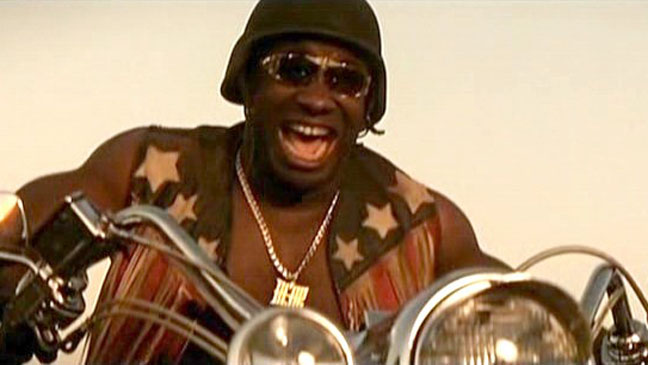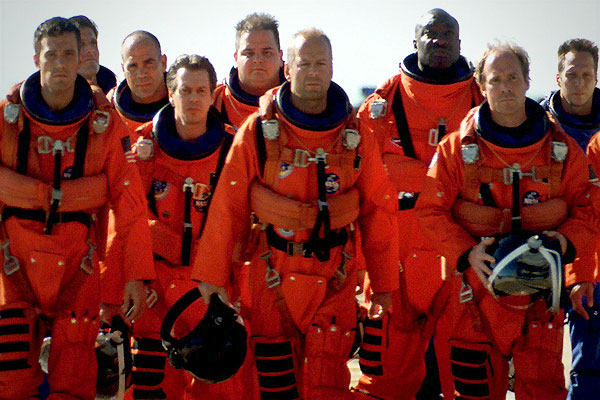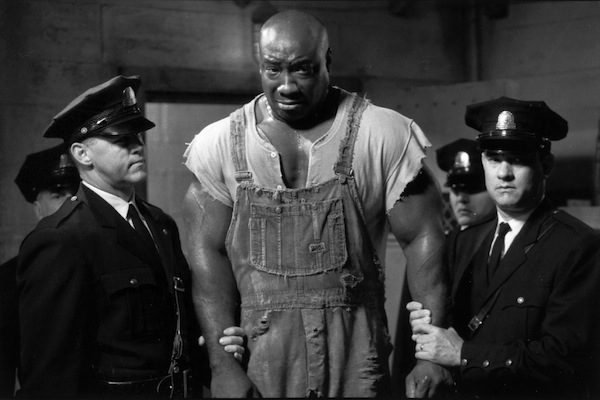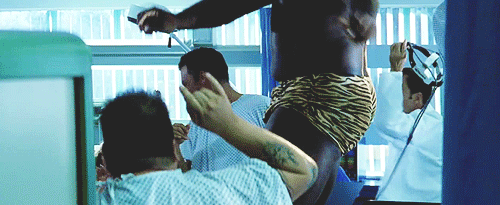Michael Clarke Duncan as
Bear in
Armageddon (1998)
by Thomas Mira y Lopez
 Claim to fame: When I was twelve, I met the stuntman for Michael Clarke Duncan in Armageddon. My parents and I were visiting my older cousin out in Amagansett, and her childhood friend was visiting as well. The friend brought over the stuntman, her boyfriend. He sat in a La-Z-Boy and made small talk. Although the stuntman was a big guy, the chair’s softness had the effect of making him look less muscular, as if he spilled out. I asked him what movies he’d worked in. Armageddon had come out a year earlier and I loved it; my favorite character was Michael Clarke Duncan’s Bear. The stuntman told me he also performed stunts for Arnold Schwarzenegger and that Schwarzenegger wasn’t as strong as he looked. The stuntman said he could bench more than Arnold. But Michael Clarke Duncan, the stuntman said, Michael Clarke Duncan was really strong.
Claim to fame: When I was twelve, I met the stuntman for Michael Clarke Duncan in Armageddon. My parents and I were visiting my older cousin out in Amagansett, and her childhood friend was visiting as well. The friend brought over the stuntman, her boyfriend. He sat in a La-Z-Boy and made small talk. Although the stuntman was a big guy, the chair’s softness had the effect of making him look less muscular, as if he spilled out. I asked him what movies he’d worked in. Armageddon had come out a year earlier and I loved it; my favorite character was Michael Clarke Duncan’s Bear. The stuntman told me he also performed stunts for Arnold Schwarzenegger and that Schwarzenegger wasn’t as strong as he looked. The stuntman said he could bench more than Arnold. But Michael Clarke Duncan, the stuntman said, Michael Clarke Duncan was really strong.
When I watch movies, I root for the characters who seem bound to die—the overly honorable guy, the quippy character of questionable loyalties, the first of the two women Bond sleeps with. I imagine a lot of viewers are like me. The fates of these characters—when, where, and how they will meet their end—inject surprise and freshness into these movies in ways their governing plots do not. In Armageddon, no one seemed more likely to die than Michael Clarke Duncan. He played the only black character of note (with apologies to Keith David, who mostly glares) and so, as the trope goes, he was doomed. I was convinced, at the movie’s end, when the remaining astronauts drew straws to see who would stay behind on the asteroid to detonate the nuke that would save the planet, that this was it. It had to be him. The biggest guy, the littlest stick.
The stuntman was light skinned enough to pass for the tan, Austrian Schwarzenegger, yet still it surprised me to learn he doubled for both. He’s easy enough to spot in Armageddon, if you know when to look. Early in the movie, Michael Clarke Duncan gets into a motorcycle chase with the cops. There’s a close-up of him wearing a tasseled, leather vest with an American flag on it. He’s bare-chested underneath, a gold necklace with a B for Bear bouncing off his pecs. He is, as Bruce Willis says, “the only black man in Kadoka, South Dakota.” Michael Clarke Duncan laughs and shouts, “Come and get Papa Bear” and then the shot pulls back to the motorcycle threading the needle of a police blockade. For that instant, the man on the motorcycle turns lighter and pudgier. He spills out. That’s the stuntman.

In Viet Thanh Nguyen’s The Sympathizer, the novel’s nameless protagonist is hired to work as an authenticity consultant on an American-made Vietnam War movie that closely resembles Apocalypse Now. The protagonist narrates, “The longer I worked on the Movie, the more I was convinced that I was not only a technical consultant on an artistic project, but an infiltrator into a work of propaganda...Movies were America’s way of softening up the rest of the world, Hollywood relentlessly assaulting the mental defenses of audiences with the hit, the smash, the spectacle, the blockbuster, and, yes, even the box office bomb. It mattered not what story these audiences watched and loved, up until the day that they themselves might be bombed by the planes they had seen in American movies.”
 This pretty much sums up Armageddon, as well as most Michael Bay movies, except you’d have to sub out planes for asteroid showers. I love the movie, sure, but I also know it’s jingoistic bullshit that feeds the collective hard-on for the mythos of the American small business—Bruce Willis plays the world’s best deep sea oil driller, yet somehow he doesn’t work for Exxon or Shell or BP but runs his own scrappy, family outfit. The movie glories in excess, whether in production or plot. My favorite Armageddon tidbit: Bruce Willis supposedly demanded a full working gym be built for him and housed in a second trailer; its construction cost $175,000 and the gym was never used.
This pretty much sums up Armageddon, as well as most Michael Bay movies, except you’d have to sub out planes for asteroid showers. I love the movie, sure, but I also know it’s jingoistic bullshit that feeds the collective hard-on for the mythos of the American small business—Bruce Willis plays the world’s best deep sea oil driller, yet somehow he doesn’t work for Exxon or Shell or BP but runs his own scrappy, family outfit. The movie glories in excess, whether in production or plot. My favorite Armageddon tidbit: Bruce Willis supposedly demanded a full working gym be built for him and housed in a second trailer; its construction cost $175,000 and the gym was never used.
In comparing Michael Bay’s work to that of Paul Greengrass, Wesley Morris, the cultural critic, argues the former cares little for “the consequences of action.” We see the explosion, but never the aftermath. “Bay,” Morris writes, “unconditionally partakes in the permissions and entitlements of the intelligence- and defense-industrial complex,” whereas “the sense of outrage and shame in a Greengrass movie would get him called a pussy in Bay village.” My twelve-year-old self might have had a hard time believing this, but now, when I recall lines like, “If we do this, then we waste a perfectly good bomb,” I start to see the point. Everyone’s itching to set off the nuke, and set up the next stunt. Dialogue is simply the way the crow flies to the next special effect.
We call this type of movie escapism, by which we mean our tendency to seek out entertainment and fantasy as distraction and relief from the troubles of reality. But this balancing act presents conundrums: Why do we the audience seek escape from our lives by watching a movie about our impending death? What exactly are we trying to escape? And is there any way to escape when we the audience, as Nguyen’s communist sympathizer puts it, actually attend “a work of propaganda,” a way of letting “American ideas and values seep into the vulnerable tissue of [our] brain and absorbent soil of [our] heart?”
In discussing the ethics of representation, Nguyen and Morris would probably both say no. If you show the aftermath of the explosion, then you’re obliged to address the stories of people other than the ones you’ve been showing. Armageddon doesn’t fuck with that. In fact, if IMDb lore is reliable, when Bay, Bruckheimer et al. learned that Deep Impact, 1997’s other asteroid movie, would blow up much of the world, they decided to sack up and film additional scenes in Paris and Shanghai, showing the large-scale destruction of the resident populations from an array of meteor showers. I wonder how many stuntmen they hired for that.
~
For a film that glories in excess, it’s disarming to see which characters are featured sparingly. It was only until a rewatch some weeks ago that I realized how little Michael Clarke Duncan has to do or say. As a kid, I knew enough about the way Hollywood depicted race to be surprised by the fact that Bear didn’t die. But, this latest time, my surprise wasn’t that he pulled the long straw. It was that he was so unimportant he was allowed to live.
Most of Bruce Willis’s astronaut team have their baldly phallic moments, moments where they are the initiators and aggressors of change. Willis blows up a nuke. William Fichtner disarms one. Ken Hudson Campbell plows through the iron ferrite surface of a foreign asteroid with a drill and Peter Stormare hits faulty machine equipment with a wrench so a shuttle will launch. Steve Buscemi both fires a machine gun into space and straddles a nuke ala Slim Pickens. There’s also a running gag about his sleeping with underage girls. Ben Affleck, one of the love interests of the film, for lack of a better expression, slips animal crackers into Liv Tyler’s underwear and nuzzles her bra strap, interactions even Buzzfeed knew to name the worst love scene of all time.
Michael Clarke Duncan has a phallic scene too, although it does not involve his own body: It’s the work of the stuntman, who rides his hog through a tight pass. Most of his dialogue—“I float away,” “Did NASA find oil on Uranus, man?”—is, if not a punchline, the length of one. Bear is larger than life, but there’s surprisingly little life in him.
Some of this might have to do with Michael Clarke Duncan’s inexperience as an actor at the time. Armageddon was one of his first films with any dialogue at all. He reportedly grew so nervous on set that much of his dialogue was cut and Bay considered firing him.  Up to this point, Duncan had only played bouncers, which was his previous profession. Fun fact: Duncan was one of Biggie’s bodyguards and was supposed to work security for him the night the rapper was shot to death. At the last minute, he and a friend switched shifts and Duncan covered Babyface instead. He never worked security again, saying in a 2012 interview, “When things like that happen you have to ask yourself, ‘Am I really ready to give up my life to do this?’ And I figured if you’re not ready to do that, you need to find some other type of work.” And so, acting it was.
Up to this point, Duncan had only played bouncers, which was his previous profession. Fun fact: Duncan was one of Biggie’s bodyguards and was supposed to work security for him the night the rapper was shot to death. At the last minute, he and a friend switched shifts and Duncan covered Babyface instead. He never worked security again, saying in a 2012 interview, “When things like that happen you have to ask yourself, ‘Am I really ready to give up my life to do this?’ And I figured if you’re not ready to do that, you need to find some other type of work.” And so, acting it was.
~
The only other stuntman of sorts I knew was a guy in college who played on the club rugby team. I also played, by which I mean I went to a few practices a week and jogged around, following plays. The team’s tradition stated that players have rugby nicknames, often vulgar, and since this guy was large, muscular, and black, he was nicknamed another familiar trope: Stuntcock.
 If Hollywood shies away from showing the aftermath of destruction because it would require a different story to be told, Morris suggests it does a similar thing when it comes to the depiction of black male sexuality, specifically black male full-frontal nudity. In a 2016 article for the New York Times Magazine entitled “Last Taboo,” Morris writes, “A black penis, even the idea of one, is still too disturbingly bound up in how America sees—or refuses to see—itself.”
If Hollywood shies away from showing the aftermath of destruction because it would require a different story to be told, Morris suggests it does a similar thing when it comes to the depiction of black male sexuality, specifically black male full-frontal nudity. In a 2016 article for the New York Times Magazine entitled “Last Taboo,” Morris writes, “A black penis, even the idea of one, is still too disturbingly bound up in how America sees—or refuses to see—itself.”
While black male sexuality is hinted at, especially when it comes to its danger or potential, it’s rarely shown in any light, much less a realistic one. We make stuntcocks out of it, content to treat it as a punchline or a special effect—watch Cameron Diaz walk through the locker room in Any Given Sunday, for example. But unlike the mythologies and false narratives put forth by movies like Armageddon and bolstered by expensive special effects—the inherent goodness and nobility of our military-industrial complex, the lionization of hard-working, tough-talking, no bullshit white guys—there’s a spin: the mythology associated with the black penis has harmful, deadly consequences.  Morris lists Emmett Till and Claude Neal as just a few of many examples. You could even add to that Michael Clarke Duncan’s portrayal of the death-row inmate John Coffey in The Green Mile, a “Super Duper Magical Negro,” to quote Spike Lee, whose supposed crime is the rape and murder of two little white girls. While American history has proven the extremes its participants have taken to keep the black body under the control of a white gaze, black male sexuality threatens to subvert or throw off that gaze. As Morris writes, “The white dick means nothing, while, whether out of revulsion or lust, the black dick means too much.”
Morris lists Emmett Till and Claude Neal as just a few of many examples. You could even add to that Michael Clarke Duncan’s portrayal of the death-row inmate John Coffey in The Green Mile, a “Super Duper Magical Negro,” to quote Spike Lee, whose supposed crime is the rape and murder of two little white girls. While American history has proven the extremes its participants have taken to keep the black body under the control of a white gaze, black male sexuality threatens to subvert or throw off that gaze. As Morris writes, “The white dick means nothing, while, whether out of revulsion or lust, the black dick means too much.”
So it’s perhaps no coincidence that, although Michael Clarke Duncan is denied any obvious phallic metaphor in Armageddon, his body—along with Liv Tyler’s—is the one most on display.
While Duncan plays spectator to the film, expressing fear, amazement, or skepticism at the action, his fellow cast play spectator to him. Arguably, Bear’s greatest action scene occurs during astronaut training, when a doctor tells him during a physical that his weight and size put him at risk of a heart attack. In response, Duncan strips off his hospital gown to reveal a leopard print Speedo underneath, the elastic band of which he shimmies down a bit before jumping on a doctor’s table to dance and gyrate. “Pork rind this!” he bellows, a reference to his unhealthy diet. The other, white crew members laugh and applaud and marvel. It is one of the few times in the movie another’s body is explicitly commented upon, the other occasions being when Ben Affleck’s giraffes explore Liv Tyler’s “high peaks” and when Owen Wilson leans over to Michael Clarke Duncan and says of a blonde female astronaut, “Is it just me or is Watts kinda hot?” (It’s worth noting too that Duncan is the one who gets in trouble for this; Watts, the hot blonde astronaut, calls him out for misbehaving and asks what will happen when she kicks him in the balls on the asteroid, hence his line “I float away.”)
“In the end,” Morris writes, “a black penis is mysterious only to those who don’t have one. Black male sexuality is of interest in American popular culture only when the people experiencing it are white.”
Michael Clarke Duncan may need a stuntman, but he’s already that other sort of stunt—a huge, John Henry-esque physical presence whose function is to draw attention for his unusual size and gentle demeanor. The movie cares little for the consequences of his action because, like much of the movie, he’s a special effect himself. And so it’s no surprise that when it comes time to show the actual dangerous stuff (the aftermath of the explosion, what’s underneath that leopard print Speedo), Bay cuts away.

Watching Armageddon now, I can’t help but sense the irony coursing through that final straw pulling scene. Michael Clarke Duncan was indeed the one doomed. He died of a heart attack in July, 2012 in Los Angeles, his body yielding to the demands embodied by such a physicality. As of today, he’s the only one of the principal Armageddon cast to have passed away. Even Billy Bob Thornton outlived him. Moreover, Duncan died specifically because of everything Armageddon calls attention to: his size, his strength, his heart.
I’m not trying to take Armageddon to task here. Most movies treat Michael Clarke Duncan as a sort of stunt, a physical specimen that’s larger than life rather than an individual life. He plays the bodyguard, the bad guy, the Magical Negro or, as the Buzzfeed article puts it, “that guy from the Green Mile.” Rarely does he play a love interest or romantic partner—I count just one title from his filmography, 2013’s From the Rough, where there might even be a whiff of romance.
Duncan was 54 at the time of his death. Another fun fact: he was engaged to be married to Omarosa Manigault at the time of his death, the reality star of Apprentice and Donald J. Trump fame. In what seems almost another type of stunt, they met in the produce section of Whole Foods and fell in love. Duncan said she was the love of his life and that she kept him up to date on politics. When he went into cardiac arrest, Omarosa performed CPR and revived him. If Hollywood ever planned a biopic of Duncan's life, starring Terry Crews for lack of other options, and they wanted to redress the lack of romantic roles in Duncan’s career, I say that scene’s a pretty good place to start. I know a stuntman we can call.
 Thomas Mira y Lopez is from New York. His first book, a collection of essays, will be published this fall by Counterpoint Press. Recent writing appears or will appear in The Georgia Review, The Kenyon Review Online, and The Southwest Review. He's an editor of Territory, a literary project about maps and other strange objects, as well as an assistant fiction editor at DIAGRAM. He currently lives and teaches in Athens, Ohio. As a child, he auditioned for a role in Woody Allen's Deconstructing Harry (1997). He never received a call back.
Thomas Mira y Lopez is from New York. His first book, a collection of essays, will be published this fall by Counterpoint Press. Recent writing appears or will appear in The Georgia Review, The Kenyon Review Online, and The Southwest Review. He's an editor of Territory, a literary project about maps and other strange objects, as well as an assistant fiction editor at DIAGRAM. He currently lives and teaches in Athens, Ohio. As a child, he auditioned for a role in Woody Allen's Deconstructing Harry (1997). He never received a call back.
~